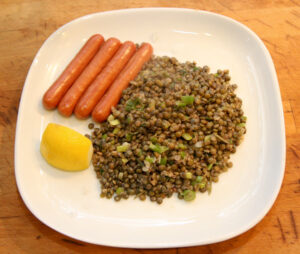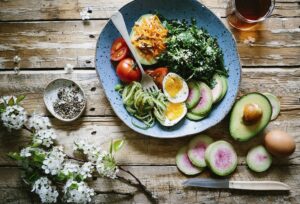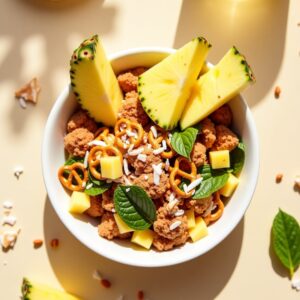Plant Based Healthy Recipes for Every Meal

In recent years, the plant-based diet has gained immense popularity, not just among vegans and vegetarians, but also among those looking to improve their health and reduce their environmental impact. A plant-based diet focuses on foods primarily from plants, including not only fruits and vegetables, but also nuts, seeds, oils, whole grains, legumes, and beans. This article will explore the benefits of a plant-based diet and provide delicious, healthy recipes for every meal of the day.
Benefits of a Plant-Based Diet
- Nutritional Advantages: Plant-based diets are rich in fiber, vitamins, and minerals, which are essential for maintaining good health. They are also lower in calories and saturated fats, which can help with weight management.
- Health Benefits: Numerous studies have shown that plant-based diets can reduce the risk of chronic diseases such as heart disease, diabetes, and certain cancers. They can also improve blood pressure, cholesterol levels, and overall heart health.
- Environmental Impact: Eating more plant-based foods can significantly reduce your carbon footprint. Plant-based diets require fewer resources and produce fewer greenhouse gases compared to diets high in animal products.
- Ethical Considerations: For many, a plant-based diet aligns with ethical beliefs about animal welfare and the desire to reduce harm to animals.
Breakfast Recipes
- Overnight Oats with Berries and Chia Seeds
- Ingredients: 1 cup rolled oats, 1 cup almond milk, 1 tablespoon chia seeds, 1/2 cup mixed berries, 1 tablespoon maple syrup, 1/2 teaspoon vanilla extract.
- Instructions: In a jar or bowl, combine oats, almond milk, chia seeds, maple syrup, and vanilla extract. Stir well, cover, and refrigerate overnight. In the morning, top with mixed berries and enjoy.
- Avocado Toast with Tomato and Basil
- Ingredients: 2 slices whole-grain bread, 1 ripe avocado, 1 tomato, fresh basil leaves, salt, and pepper to taste.
- Instructions: Toast the bread slices. Mash the avocado and spread it on the toast. Slice the tomato and place on top of the avocado. Garnish with fresh basil leaves, and season with salt and pepper.
Lunch Recipes
- Quinoa and Black Bean Salad
- Ingredients: 1 cup cooked quinoa, 1 can black beans (rinsed and drained), 1 red bell pepper (diced), 1/4 cup chopped cilantro, juice of 1 lime, 1 tablespoon olive oil, salt, and pepper to taste.
- Instructions: In a large bowl, combine quinoa, black beans, bell pepper, and cilantro. In a small bowl, whisk together lime juice, olive oil, salt, and pepper. Pour the dressing over the salad and toss to combine.
- Chickpea and Avocado Wrap
- Ingredients: 1 can chickpeas (rinsed and drained), 1 ripe avocado, 1 tablespoon lemon juice, 1/4 cup chopped red onion, whole-grain wraps, salt, and pepper to taste.
- Instructions: In a bowl, mash the chickpeas and avocado together. Add lemon juice, red onion, salt, and pepper, and mix well. Spread the mixture onto a whole-grain wrap, roll it up, and enjoy.
Dinner Recipes
- Lentil and Vegetable Stir-Fry
- Ingredients: 1 cup cooked lentils, 2 cups mixed vegetables (such as broccoli, bell peppers, and carrots), 2 tablespoons soy sauce, 1 tablespoon sesame oil, 1 teaspoon grated ginger, 2 cloves garlic (minced).
- Instructions: In a large pan, heat sesame oil over medium heat. Add garlic and ginger, and sauté for 1 minute. Add mixed vegetables and stir-fry until tender. Add cooked lentils and soy sauce, and stir until heated through.
- Stuffed Bell Peppers with Brown Rice and Spinach
- Ingredients: 4 bell peppers, 1 cup cooked brown rice, 1 cup chopped spinach, 1/2 cup diced tomatoes, 1/4 cup nutritional yeast, salt, and pepper to taste.
- Instructions: Preheat oven to 375°F (190°C). Cut the tops off the bell peppers and remove the seeds. In a bowl, combine brown rice, spinach, tomatoes, nutritional yeast, salt, and pepper. Stuff the mixture into the bell peppers and place them in a baking dish. Cover with foil and bake for 30-35 minutes.
Snack Ideas
- Roasted Chickpeas
- Ingredients: 1 can chickpeas (rinsed and drained), 1 tablespoon olive oil, 1 teaspoon paprika, 1/2 teaspoon garlic powder, salt, and pepper to taste.
- Instructions: Preheat oven to 400°F (200°C). Pat chickpeas dry with a paper towel. In a bowl, toss chickpeas with olive oil, paprika, garlic powder, salt, and pepper. Spread on a baking sheet and roast for 20-30 minutes, stirring occasionally, until crispy.
- Fruit and Nut Energy Bites
- Ingredients: 1 cup dates, 1/2 cup almonds, 1/2 cup walnuts, 1/4 cup shredded coconut, 1 tablespoon cocoa powder.
- Instructions: In a food processor, combine dates, almonds, walnuts, coconut, and cocoa powder. Process until the mixture comes together. Roll into small balls and refrigerate for at least 30 minutes before serving.
Tips for Transitioning to a Plant-Based Diet
- Start Slowly: Begin by incorporating more plant-based meals into your diet gradually. You don’t have to go completely plant-based overnight.
- Experiment with New Ingredients: Try new fruits, vegetables, grains, and legumes to keep your meals exciting and varied.
- Plan Your Meals: Planning your meals in advance can help you stick to a plant-based diet and ensure you have all the necessary ingredients on hand.
- Find Plant-Based Alternatives: Look for plant-based alternatives to your favorite animal-based products, such as plant-based milk, cheese, and meat substitutes.
- Stay Informed: Educate yourself about the nutritional aspects of a plant-based diet to ensure you’re getting all the essential nutrients your body needs.
Conclusion
Adopting a plant-based diet can be a rewarding journey that benefits your health, the environment, and animal welfare. By incorporating these delicious and nutritious plant-based recipes into your daily routine, you can enjoy a variety of flavors and textures while nourishing your body. Whether you’re looking to make a complete transition or simply want to add more plant-based meals to your diet, these recipes offer a great starting point for a healthier lifestyle.
FAQs: Plant-Based Healthy Recipes for Every Meal
1. What is a plant-based diet?
A plant-based diet focuses on foods primarily from plants. This includes not only fruits and vegetables but also nuts, seeds, oils, whole grains, legumes, and beans. It emphasizes whole, minimally processed foods and limits or excludes animal products.
2. Is a plant-based diet the same as being vegan or vegetarian?
Not necessarily. While vegans and vegetarians follow plant-based diets, a plant-based diet can be more flexible. Some people who follow a plant-based diet may still consume small amounts of animal products, whereas vegans avoid all animal products, and vegetarians avoid meat but may consume dairy and eggs.
3. How can I ensure I’m getting enough protein on a plant-based diet?
There are plenty of plant-based protein sources, including beans, lentils, chickpeas, tofu, tempeh, quinoa, nuts, seeds, and whole grains. By incorporating a variety of these foods into your meals, you can easily meet your protein needs.
4. Are plant-based diets suitable for children and pregnant women?
Yes, plant-based diets can be suitable for people of all ages, including children and pregnant women, as long as they are well-planned. It’s important to ensure adequate intake of essential nutrients such as protein, iron, calcium, vitamin B12, and omega-3 fatty acids. Consulting with a healthcare provider or a registered dietitian can help ensure nutritional needs are met.
5. How can I make sure I’m getting enough vitamins and minerals on a plant-based diet?
Eating a wide variety of fruits, vegetables, whole grains, and legumes can help you get the necessary vitamins and minerals. Pay special attention to nutrients like vitamin B12, iron, calcium, and omega-3 fatty acids, which may require fortified foods or supplements.
6. Can a plant-based diet help with weight loss?
Many people find that a plant-based diet can aid in weight loss due to its emphasis on whole, nutrient-dense foods that are lower in calories and high in fiber. This can help you feel full and satisfied while consuming fewer calories.
7. How do I deal with cravings for meat or dairy products?
Cravings can be managed by finding plant-based alternatives that satisfy similar tastes and textures. For example, try plant-based burgers, dairy-free cheeses, or nut-based milk. Experimenting with herbs, spices, and cooking techniques can also enhance the flavor of plant-based dishes.
8. Is it expensive to follow a plant-based diet?
A plant-based diet can be cost-effective, especially when focusing on whole foods like grains, beans, and seasonal produce. Buying in bulk and planning meals can help reduce costs. Processed plant-based products can be more expensive, so it’s best to use them occasionally.
9. How can I make plant-based meals more exciting?
Experiment with different cuisines and cooking methods to keep meals interesting. Try incorporating a variety of herbs, spices, and sauces to enhance flavors. Exploring new recipes and ingredients can also add excitement to your meals.
10. What are some easy plant-based snacks?
Some easy plant-based snacks include fresh fruit, raw vegetables with hummus, roasted chickpeas, nuts and seeds, energy bites, and whole-grain crackers with avocado or nut butter.
Share this content:

A seasoned chef with over 10 years of experience in New York. I passionately share my journey and healthy, flavorful recipes online.













Post Comment